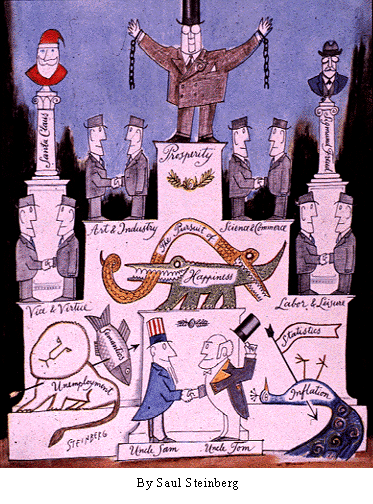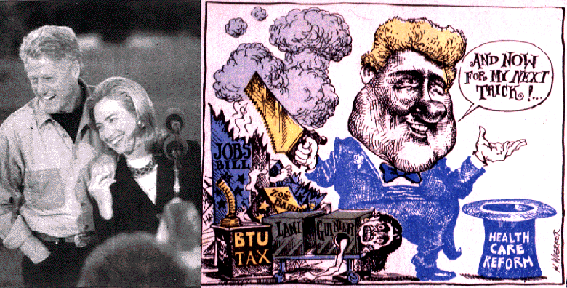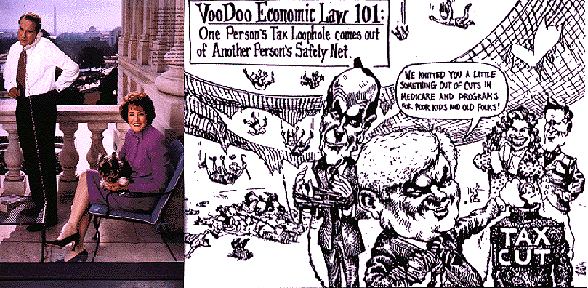



There are also the iconic images that the visual arts present to us. Some of the visual ideas used are very old, and are tied to folklore or other shared cultural ideas, such as the idea of a glass half full or half empty, or the dangers of a hole in the bucket or changing horses in midstream. We also know that sex sells, or at least grabs our attention. The images of the human body presented in fashion advertising and sports images also affect our perception/level of satisfaction with our own bodies.
Other ideas spring from the new media that have emerged in this century; especially from film and television. When these images are used in advertising or social commentary images, we know how we are expected to respond to them. Examples might include the image of a TV screen containing a slick, smiling "talking head" or one of a more informal, shirt-sleeved individual leaning on the back yard fence. Which one are we expected to think is trustworthy?
Or we might be presented with the image of a confrontation between two men, one in a white hat, one in a black hat. This link will take you to a collection of posters from World War II, a good set of examples of how iconic images have been used effectively to persuade for a long time.
Of course since the advent of television, the presence of image-based persuasion in our lives has vastly increased.

In general, we tend to react to images emotionally, and usually without really analyzing them. The saying goes: "Seeing is believing," but that may not be true. Consider the images shown on this website dedicated to the principle that seeing is not believing . Vision is one of the most elementary functions of the brain, a function that evolved long before language and logic. So images get to us on that reptilian level of thinking, where we are less likely to screen information. When these kinds of images are used skillfully, it can affect our response to the other information being presented to us. Images are associated with advertising, economic statistics, with points of view on social and policy issues, and of course with political choices. The images from past presidential elections shown here show how our perception of a candidate may be altered by the kinds of images that the media chooses to present to us. We have Clinton the happily married family man, or Clinton the trickster. On the other hand, below we see two views of his 1996 opponent Bob Dole, who was very sensitive to the visual presentation of his physical health. Throughout his career he has attempted to disguise the fact that he has severe disabilities as a result of injuries incurred during World War II. He therefore always has a pencil in his unusable right hand. In the 1996 election he further had to protect his image from the perception of his age, and attempted to show himself as vigorous and active.

When we react to a candidate or a cause, we need to be very conscious of images used to either reinforce or undercut a point of view; and try to separate image from real information. The less we are conscious of the power of images, the more we are likely to be subject to manipulation.
Elections always involve image strategies, and increasingly seem to be a lot more than an opportunity to choose based on policy issues, or moral principles. It is also a referendum on how effective media and image strategies can be in inspiring voters to support a party and at the same time, discourage other voters sufficiently to make them stay home and leave the field to the opposition. If sensational media coverage of scandals can be credited with deciding an election, it is even more likely that scandal will be used as an election strategy in the future. However you feel about the current government, you should vote your point of view, but you should do your best to separate image from substance, and think critically about the strategies that are being used to sway your feelings. That is, be very sure you are voting for the substance, and not for the image.
Younger voters are traditionally the least likely to vote, but since 2000 it is very apparent that a small number of voters can make the difference in an election. Your single vote can count for a lot. A big part of making responsible decisions is a degree of skepticism about the images presented by political candidates. Take a look at the websites of the Republican Party , the Democratic party , and consider the way in which they present themselves, their opposition, and various potential candidates. Are the images relevant to the real issues? Do the images selected contain any subtle features intended to "push our buttons" visually and emotionally?
In 2001 the tragic events of September 11 diverted our attention almost completely from domestic political and social issues. These tragic events generated more unanimity of purpose in this country than there had been for many years, although with the passage of time differences in agendas and intentions rose to the surface again. The 2004 election has polarized public opinion to an almost unprecedented degree, and this polarization has resulted in the most emotional, least rational election process ever. The marketing of political candidates is accomplished to a great extent through the manipulation of iconic ideas, in which image and symbol carry great weight. A look at recent political cartoons confirms that we do not live in easy times. Representations of President Bush markedly changed in the weeks following 9/11 as Americans united behind their leader. Subsequently, other kinds of images were invoked to redefine the President, and define his opponents. We need to look carefully at the way in which the candidates are being represented to us. We need to continue to analyze the visual images that are brought to bear on us and that are coloring our responses to unfolding events and issues domestic and international. The war on terror is the dominant new issue of our age. One common question in the weeks following the 9/11 attacks was "why do those people hate us this much?" And since Iraq we are being confronted with hostility from those our government intended to liberate, a situation surprising to some but not to all. Therefore we need to learn to recognize the bias in images put forth by all sides of the debate. We have to get beyond the emotional response to such non-verbal pressure to the facts of the situation that really matter. This takes effort, and time, and a willingness to look at more than a source of information that we already know and are comfortable with. Political cartoons from the international press are one way to gain a view of ourselves from a point of view we have generally ignored.Images can speak quite clearly across cultural and language barriers. Most of us have until recently taken little interest in how we are perceived abroad, and how public opinion is shaped in the rest of the world. Now more than ever we need to remember that when anyone does not understand how visual persuasion works, they are very likely to be putty in the hands of those who do.
| |
 |